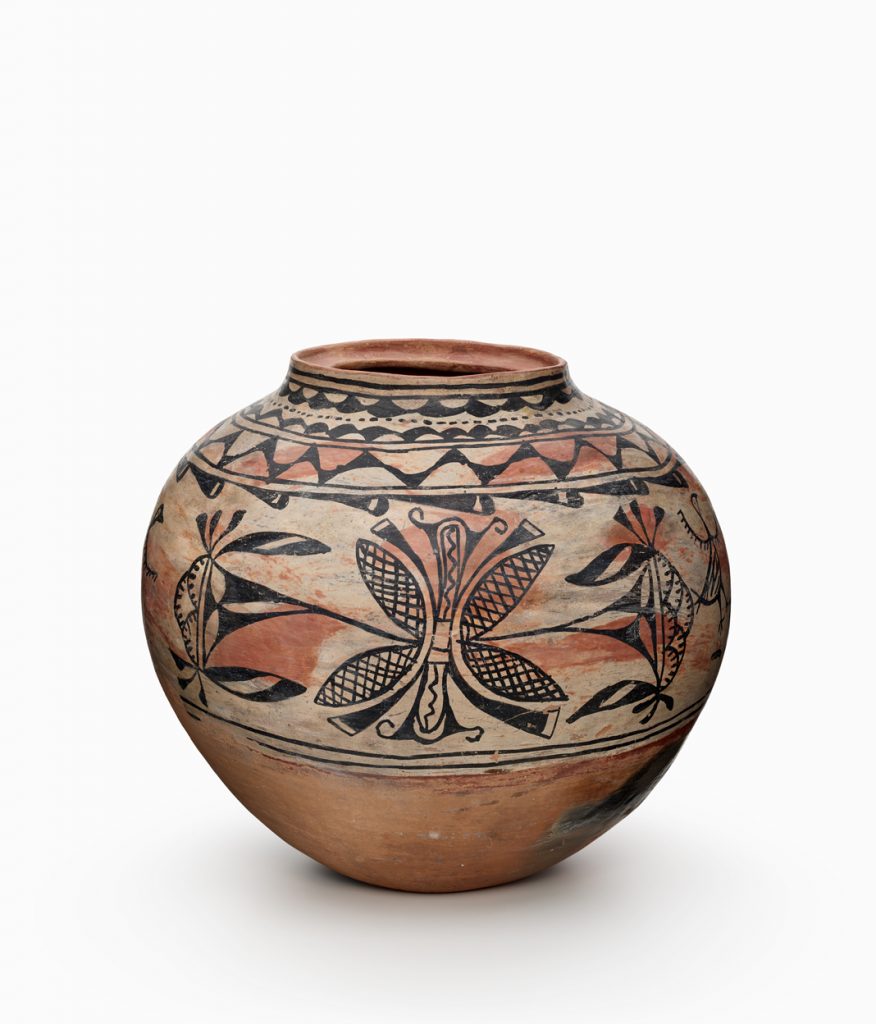Tony R. Chavarria
Santa Clara Pueblo
Curator Tony R. Chavarria (Santa Clara Pueblo) has more than thirty years’ experience collaborating with tribes and curating Native material culture. As Curator of Ethnology at the Museum of Indian Arts and Culture/Laboratory of Anthropology, Santa Fe, he has curated many exhibitions, including Comic Art Indigène and What’s New in New 2, and in 2018 he was co-curator of Creating Tradition: Innovation and Change in American Indian Art, the first Native exhibition at Epcot in Orlando, Florida. He is an occasional potter and artist.
Tony chose the following for the Grounded in Clay exhibit:
Pindii Among the Clouds
The moment I saw this jar, I smiled. I saw what the painter observed all those years ago.
As soon as our ancestors utilized the gift of clay to shape vessels for water, cooking, and storage, they began to incorporate elements of the world around them. Their world can be seen in the materials they used, the shapes they formed, and, later, in what they painted on the clay. This jar is a great example of the Pueblo Indian aesthetic. It is an aesthetic not confined to art, since “art” was only a part of making and being. The beauty created in clay is as imperfect as we are, but soars with meaning and purpose. This jar shows proudly its age and the marks of a long life. The scratches and loss of slip affront modern aesthetics, yet the jar’s real beauty remains undiminished. Abstract and representational designs live next to one another, creating multiple layers of meaning. Among ancient patterns of water and life … the turkeys dance.
Pindii¹ have lived with us for many centuries. They are an important part of our history and culture. Their feathers, meat, and bones are used to sustain our bodies and spirit. They inspired the tale of Turkey Girl, a Pueblo Cinderella story in which they tolerate their “irksome captivity.” They are wise and nurturing and, although large, are capable of hurling themselves into the air (their modern domesticated relatives notwithstanding). These magnificent birds, considered ugly by some, are actually creatures of great beauty. They stomp, dance, strut, and sometimes fight, just as we lowly humans do. Although they are aloft on this jar, they keep us grounded. The painter deemed these dancing/fighting/flying pindii worthy of painting, to show that they are a special part of our world and forever should be.
The potters of the past speak to us now and into the future. They give us a glimpse of their world and how they lived in it. They have passed on the knowledge, meaning, and responsibility of creating culture in clay. We must retain this practice because it is more than art; it is an integral part of who we are as Pueblo people. We must create so that our descendants can see who we were, just as we look back to those who made these pots. Just as we are doing now by looking at these ancestral works, future generations will be able to see what was important to us. Through humble elements of the earth, gifts of the Clay Mother, we are connected. We, our ancestors, and our descendants share our culture, the plants and animals we live with, what we sanctify, what we see in the sky and stars, and what makes us smile.
¹Tewa for “turkey.”

